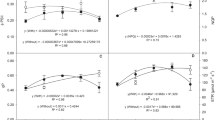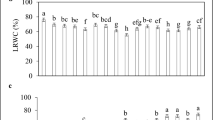Abstract
We investigated the effects of exogenous sodium nitroprusside (SNP), a nitric oxide (NO) donor, on growth of cucumber (Cucumis sativus L., cv. Jinyou No.1) seedlings and antioxidant enzyme activities in cucumber leaves under waterlogging stress. The growth of cucumber seedlings was significantly inhibited when plants were exposed to waterlogging, whereas shoot spraying with SNP significantly alleviated the inhibition of growth from this type of stress: height, fresh and dry weights of the flooded plants increased obviously. Waterlogging also caused the activation of the antioxidant enzymes (superoxide dismutase (SOD), peroxidase (POD), catalase (CAT), and ascorbate peroxidase (APX)), the reduction of the chlorophyll content, and the accumulation of MDA and protein in leaves. It was found that SNP treatment further potentiated the antioxidant enzyme activities and maintained the chlorophyll and protein content during the entire water-logging period; however, it reduced the MDA content. Thus, NO protects plants from oxidative damage and promotes growth by activation of antioxidant enzymes in leaves in an extent sufficient for the alleviation of membrane injury. However, exogenous NO had no significant effects on cucumber seedlings growth and antioxidant enzyme activities under nonstress conditions.
Similar content being viewed by others
Abbreviations
- APX:
-
ascorbate peroxidase
- CAT:
-
catalase
- O ·−2 :
-
superoxide radical
- ONOO− :
-
peroxynitrite
- POD:
-
peroxidase
- SNP:
-
sodium nitroprusside
- SOD:
-
superoxide dismutase
References
Anton, J.M., Marjolein, C.H., Joris, J.B., Robert, A.M., Jordi, B., and Laurentius, A.C., Submergence research using Rumex palustris as a model: looking back and going forward, J. Exp. Bot., 2002, vol. 53, pp. 391–398.
Sairam, R.K., Dharmar, K., Chinnusamy, V., and Meena, R.C., Waterlogging-induced increase in sugar mobilization, fermentation and related gene expression in the roots of mung bean (Vigna radiate), J. Plant Physiol., 2009, vol. 166, pp. 602–616.
Li, C., Jiang, D., Wollenweber, B., Li, Y., Dai, T., and Cao, W., Waterlogging pretreatment during vegetative growth improves tolerance to waterlogging after anthesis in wheat, Plant Sci., 2011, vol. 180, pp. 672–678.
Bailey-Serres, J., Fukao, T., Ronald, P., Ismail, A., Heuer, S., and Mackill, D., Submergence tolerant rice: SUB1’s journey from landrace to modern cultivar, Rice, 2010, vol. 3, pp. 138–147.
Singh, S., Mackill, D.J., and Ismail, A.M., Tolerance of long-term partial stagnant flooding is independent of the SUB1 locus in rice, Field Crops Res., 2011, vol. 121, pp. 311–323.
Yordanova, R.Y. and Popova, L.P., Photosynthetic response of barley plants to soil flooding, Photosynthetica, 2001, vol. 39, pp. 515–520.
Kubiś, J., Exogenous spermidine differentially alters activities of some scavenging system enzymes, H2O2 and superoxide radical levels in water-stressed cucumber leaves, J. Plant Physiol., 2008, vol. 165, pp. 397–406.
Yiu, J.C., Juang, L.D., Fang, D.Y.T., Liu, C.W., and Wu, S.J., Exogenous putrescine reduces flooding-induced oxidative damage by increasing the antioxidant properties of Welsh onion, Sci. Hortic., 2009, vol. 120, pp. 306–314.
Yiu, J.C., Tseng, M.J., and Liu, C.W., Exogenous catechin increases antioxidant enzyme activity and promotes flooding tolerance in tomato (Solanum lycopersicum L.), Plant Soil, 2011, vol. 344, pp. 213–225.
Jiang, T., Zheng, X.L., Li, J.R., Jing, G.X., Cai, L.Y., and Ying, T.J., Integrated application of nitric oxide and modified atmosphere packaging to improve quality retention of button mushroom (Agaricus bisporus), Food Chem., 2011, vol. 126, pp. 1693–1699.
Dordas, C., Rivoal, J., and Hill, R.D., Plant haemoglobins, nitric oxide and hypoxic stress, Ann. Bot., 2003, vol. 91, pp. 173–178.
Borisjuk, L., Macherel, D., Benamar, A., Wobus, U., and Rolletschek, H., Low oxygen sensing and balancing in plant seeds: a role for nitric oxide, New Phytol., 2007, vol. 176, pp. 813–823.
Benamar, A., Rolletschek, H., Borisjuk, L., Avelange-Macherel, M.-H., Curien, G., Mostefai, H.A., Andriantsitohaina, R., and Macherel, D., Nitrite-nitric oxide control of mitochondrial respiration at the frontier of anoxia, Biochim. Biophys. Acta, 2008, vol. 1777, pp. 1268–1275.
Igamberdiev, A.U., Bykova, N.V., Shah, J.K., and Hill, R.D., Anoxic nitric oxide cycling in plants: participating reactions and possible mechanisms, Physiol. Plant., 2010, vol. 138, pp. 393–404.
Igamberdiev, A.U. and Hill, R.D., Plant mitochondrial function during anaerobiosis, Ann. Bot., 2009, vol. 103, pp. 259–268.
Giannopotitis, C.N. and Ries, S.K., Superoxide dismutase in higher plants, Plant Physiol., 1977, vol. 59, pp. 309–314.
Egley, G.H., Paul, R.N., Vaughn, K.C., and Duke, S.O., Role of peroxidase in the development of water-impermeable seed coats in Sida spinosa L., Planta, 1983, vol. 157, pp. 224–232.
Nakano, Y. and Asada, K., Hydrogen peroxide scavenged by ascorbate-specific peroxidase in spinach chloroplasts, Plant Cell Physiol., 1981, vol. 22, pp. 867–880.
Cakmak, I. and Marschner, H., Magnesium deficiency and high light intensity enhance activities of superoxide dismutase, ascorbate peroxidase, and glutathione reductase in bean leaves, Plant Physiol., 1992, vol. 98, pp. 1222–1227.
Yu, B.J., Li, S.N., and Liu, Y.L., Comparison of ion effects of salt injury in soybean seedlings, J. Nanjing Agric. Univ., 2002, vol. 25, pp. 5–9 (in Chinese).
Bradford, M.M., A rapid and sensitive method for the quantitation of microgram quantities of protein utilizing the principle of protein-dye binding, Anal. Biochem., 1976, vol. 72, pp. 248–254.
Heath, R.L. and Packer, L., Photoperoxidation in isolated chloroplasts. I. Kinetics and stoichiometry of fatty acid peroxidation, Arch. Biochem. Biophys., 1968, vol. 125, pp. 189–198.
Hashiguchi, A., Sakata, K., and Komatsu, S., Proteome analysis of early-stage soybean seedlings under flooding stress, J. Proteome Res., 2009, vol. 8, pp. 2058–2069.
Leshem, Y.Y. and Haramaty, E., Plant aging: the emission of NO and ethylene and effect of NO-releasing compounds on growth of pea (Pisum sativum) foliage, J. Plant Physiol., 1996, vol. 148, pp. 258–263.
Nanjo, Y., Maruyama, K., Yasue, H., Yamaguchi-Shinozaki, K., Shinozaki, K., and Komatsu, S., Transcriptional responses to flooding stress in roots including hypocotyl of soybean seedlings, Plant Mol. Biol., 2011, vol. 77, pp. 129–144.
Wang, K.H. and Jiang, Y.W., Antioxidant responses of creeping bentgrass roots to waterlogging, Crop Sci., 2007, vol. 47, pp. 232–238.
Lin, K.H., Chao, P.Y., Yang, C.M., Cheng, W.C., Lo, H.F., and Chang, T.R., The effects of flooding and drought stresses on the antioxidant constituents in sweet potato leaves, Bot. Stud., 2006, vol. 47, pp. 417–426.
Clark, D., Durner, J., Navarre, D.A., and Klessig, D.F., Nitric oxide inhibition of tobacco catalase and ascor-bate peroxidase, Mol. Plant-Microbe Interact., 2000, vol. 13, pp. 1380–1384.
Tanou, G., Molassiotis, A., and Diamantidis, G., Hydrogen peroxide- and nitric oxide-induced systemic antioxidant prime-like activity under NaCl-stress and stress-free conditions in citrus plants, J. Plant Physiol., 2009, vol. 166, pp. 1904–1913.
Ahmed, S., Nawata, E., Hosokawa, M., Domae, Y., and Sakuratani, T., Alterations in photosynthesis and some antioxidant enzymatic activities of mungbean subjected to waterlogging, Plant Sci., 2002, vol. 163, pp. 117–123.
Author information
Authors and Affiliations
Corresponding author
Additional information
This text was submitted by the authors in English.
Rights and permissions
About this article
Cite this article
Fan, H.F., Du, C.X., Ding, L. et al. Exogenous nitric oxide promotes waterlogging tolerance as related to the activities of antioxidant enzymes in cucumber seedlings. Russ J Plant Physiol 61, 366–373 (2014). https://doi.org/10.1134/S1021443714030042
Received:
Published:
Issue Date:
DOI: https://doi.org/10.1134/S1021443714030042




